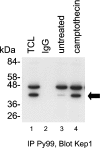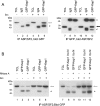Phosphorylation status of the Kep1 protein alters its affinity for its protein binding partner alternative splicing factor ASF/SF2
- PMID: 16834570
- PMCID: PMC1635453
- DOI: 10.1042/BJ20060384
Phosphorylation status of the Kep1 protein alters its affinity for its protein binding partner alternative splicing factor ASF/SF2
Abstract
Mutations in the Drosophila kep1 gene, encoding a single maxi KH (K homology) domain-containing RNA-binding protein, result in a reduction of fertility in part due to the disruption of the apoptotic programme during oogenesis. This disruption is concomitant with the appearance of an alternatively spliced mRNA isoform encoding the inactive caspase dredd. We generated a Kep1 antibody and have found that the Kep1 protein is present in the nuclei of both the follicle and nurse cells during all stages of Drosophila oogenesis. We have shown that the Kep1 protein is phosphorylated in ovaries induced to undergo apoptosis following treatment with the topoisomerase I inhibitor camptothecin. We have also found that the Kep1 protein interacts specifically with the SR (serine/arginine-rich) protein family member ASF/SF2 (alternative splicing factor/splicing factor 2). This interaction is independent of the ability of Kep1 to bind RNA, but is dependent on the phosphorylation of the Kep1 protein, with the interaction between Kep1 and ASF/SF2 increasing in the presence of activated Src. Using a CD44v5 alternative splicing reporter construct, we observed 99% inclusion of the alternatively spliced exon 5 following kep1 transfection in a cell line that constitutively expresses activated Src. This modulation in splicing was not observed in the parental NIH 3T3 cell line in which we obtained 7.5% exon 5 inclusion following kep1 transfection. Our data suggest a mechanism of action in which the in vivo phosphorylation status of the Kep1 protein affects its affinity towards its protein binding partners and in turn may allow for the modulation of alternative splice site selection in Kep1-ASF/SF2-dependent target genes.
Figures






Similar articles
-
Specific inhibition of serine- and arginine-rich splicing factors phosphorylation, spliceosome assembly, and splicing by the antitumor drug NB-506.Cancer Res. 2001 Sep 15;61(18):6876-84. Cancer Res. 2001. PMID: 11559564
-
The splicing factor ASF/SF2 is associated with TIA-1-related/TIA-1-containing ribonucleoproteic complexes and contributes to post-transcriptional repression of gene expression.FEBS J. 2010 Jun;277(11):2496-514. doi: 10.1111/j.1742-4658.2010.07664.x. Epub 2010 Apr 30. FEBS J. 2010. PMID: 20477871
-
ASF/SF2-like maize pre-mRNA splicing factors affect splice site utilization and their transcripts are alternatively spliced.Gene. 2004 Sep 15;339:25-37. doi: 10.1016/j.gene.2004.06.047. Gene. 2004. PMID: 15363843
-
Tissue development and RNA control: "HOW" is it coordinated?Trends Genet. 2008 Feb;24(2):94-101. doi: 10.1016/j.tig.2007.11.009. Epub 2008 Jan 14. Trends Genet. 2008. PMID: 18192064 Review.
-
[Alternative splicing: a novel pharmacological target with wide therapeutic potential].Bull Acad Natl Med. 2005 May;189(5):949-59; discussion 959-61. Bull Acad Natl Med. 2005. PMID: 16433465 Review. French.
Cited by
-
Evolutionary Dynamics of GLD-1-mRNA complexes in Caenorhabditis nematodes.Genome Biol Evol. 2014 Dec 9;7(1):314-35. doi: 10.1093/gbe/evu272. Genome Biol Evol. 2014. PMID: 25502909 Free PMC article.
-
Discovering structural cis-regulatory elements by modeling the behaviors of mRNAs.Mol Syst Biol. 2009;5:268. doi: 10.1038/msb.2009.24. Epub 2009 Apr 28. Mol Syst Biol. 2009. PMID: 19401680 Free PMC article.
-
Blom7alpha is a novel heterogeneous nuclear ribonucleoprotein K homology domain protein involved in pre-mRNA splicing that interacts with SNEVPrp19-Pso4.J Biol Chem. 2009 Oct 16;284(42):29193-204. doi: 10.1074/jbc.M109.036632. Epub 2009 Jul 29. J Biol Chem. 2009. PMID: 19641227 Free PMC article.
References
-
- Schwerk C., Schulze-Osthoff K. Regulation of apoptosis by alternative re-mRNA splicing. Mol. Cell. 2005;19:1–13. - PubMed
-
- Wang L., Miura M., Bergeron L., Zhu H., Yuan J. Ich-1, an Ice/ced-3-related gene, encodes both positive and negative regulators of programmed cell death. Cell. 1994;78:739–750. - PubMed
-
- Boise L. H., Gonzalez-Garcia M., Postema C. E., Ding L., Lindsten T., Turka L. A., Mao X., Nunez G., Thompson C. B. bcl-x, a bcl-2-related gene that functions as a dominant regulator of apoptotic cell death. Cell. 1993;74:597–608. - PubMed
-
- Shaham S., Horvitz H. R. An alternatively spliced C. elegans ced-4 RNA encodes a novel cell death inhibitor. Cell. 1996;86:201–208. - PubMed
-
- Srinivasula S. M., Ahmad M., Guo Y., Zhan Y., Lazebnik Y., Fernandes-Alnemri T., Alnemri E. S. Identification of an endogenous dominant-negative short isoform of caspase-9 that can regulate apoptosis. Cancer Res. 1999;59:999–1002. - PubMed
Publication types
MeSH terms
Substances
LinkOut - more resources
Full Text Sources
Molecular Biology Databases
Research Materials
Miscellaneous

